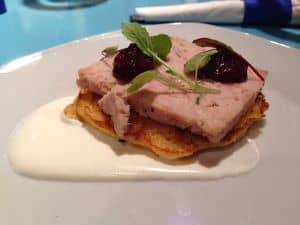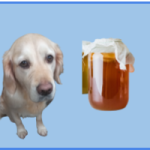
It’s the same problem over and over again. Can I give my beloved dog just a tiny bit of what I’m having?
All pet parents know the terrible sense of guilt when the dog looks at you with those large pleading eyes and you don’t know whether you should give him a morsel of what you’re having for dinner.
Many human foods are bad for dogs, but what about pate in its many delicious forms? Is it safe for dogs?
Unfortunately, there is no clear answer to this question. It all depends on the type of liver pate we’re talking about, your dog’s overall health and, of course, how much pate you are planning to give him. And how often.
In this article, we’ll have a look at the different types of pate to see which are safe for dogs and why some of them are quite dangerous.
What is liver pate?
Liver pate is a food that originates in Northern Europe, which today you can find in supermarkets all over the world. A pate is a spread made originally from pork liver, pork fat and various spices, depending on the recipe. Today, you can also find chicken or turkey-based pate, generally thought to be healthier than pork.
Pate is made by grounding the liver, finely or coarsely, mixing it with fat, eggs and spices, and baking it in the oven.
At first sight, this doesn’t sound too bad, but the devil is in the details. In this case, the details are the ingredients list of the pate at your local store. One look at that and the pate doesn’t seem like such a healthy food for your dog. Or for you for that matter, but it’s your choice what you do with your health. As far as the dog is concerned, it’s not about choice. You are responsible for your dog’s health and you should be careful what you feed him.
Can dogs eat liver pate?
In itself, liver is quite a superfood for dogs, as it is rich in protein, vitamins and minerals.
Beef liver is the best of all as it provides loads of vitamin A, B2 and B12. It also contains iron, copper and zinc, which support brain function, cellular health, healthy bones and joints. It is also lower in fat as compared to pork or chicken liver.
Now, let’s have a look at a popular type of liver pate and see what it actually contains.
For one thing, the liver content is only 33%. So, what’s in the other 61%?
You have pork fat, water, milk, salt, eggs, garlic and other spices.
The ingredients may vary in percentage between various products, but just to give you a general idea, here are the nutritional values for pork liver pate.
One small serving of 1 oz (28.5 g) provides 90 calories. And, it’s just a small serving!
One other thing you’ll notice is that roughly 70% of those calories comes from fat. One serving has 7.9 g of fat, which is quite high for a dog.
Another thing you should always check on food labels is the salt content. In this case, we’re talking about 197 mg of salt for a small serving. This represents 9% of the Recommended Daily Allowance for a healthy adult. For a medium sized dog that’s 4 or 5 times as much.
And then there’s garlic in that can of liver pate and it can be toxic to dogs. According to experts, a dog would have to eat 15-30 grams of garlic per kilogram of body weight for it to cause damage. Clearly this is not the case with liver pate, which has way less garlic, but it’s something to keep in mind.
Looking on the bright side, that small serving of liver pate provides many of the vitamins your dog needs, as well as 1.6 grams of iron, which prevents anemia.
All in all, a small serving of liver pate won’t cause any harmful consequences, but that doesn’t mean you should feed your dog pate every day or in large quantities.
Also, remember that these values refer to a serving of high-quality liver pate. Many of the products you’ll find at the supermarket are of a much lower quality. Read the label carefully before buying as the liver pate on offer might contain even less liver and a ridiculously high level of salt, as well as additives.
Can a dog eat pate?
There’s a fine distinction between liver pate and pate. The latter usually refers to a paste that contains mostly meat and little to no offal. Take, for instance, this pure chicken pate, which, according to the label, is 100% fresh human-grade meat. There are no preservatives in this product and they sure don’t mention any salt. Such a product is 31% raw protein which supports muscle growth and is therefore quite good for a dog.
According to the manufacturer, this product is an excellent filler for Kong toys and will provide much needed entertainment for your dog.
If you shop around for pate made for humans, those will certainly contain salt and spices, so use caution when feeding them to your dog.
Can a dog eat Brussels pate?
While most people consider Brussels pate a very tasty treat, this product is not really recommended for dogs.
If you look at the ingredients, you’ll see that the product has 32% pork liver and 32% pork fat. One small serving provides 13% percent of the RDA for an adult. For a dog, that’s really too much and it can cause a lot of health issues. Foods that are high in fat are not recommended for pets that are prone to obesity. At the same time, too much in a dog’s diet can cause pancreatitis, which is a very serious condition and it can be fatal.
Experts say that fat should account for no more than 10% of a dog’s food.
There’s also a problem with onions in Brussels pate. When it comes to dogs, onions are even more dangerous than garlic. It only takes one mid-sized onion to cause problems to a medium-sized 20 kg dog. All parts of the onion plant are considered toxic to dogs, and the onion powder found in Brussels pate is even more dangerous as it is more concentrated.
Can a dog eat duck and orange pate?
Duck and orange pate is a delicacy, but you’ll be disappointed to hear it only contains 18% duck liver. And it also has pork fat. In fact, most types of liver pates have pork fat, even if they’re marketed as duck or chicken pate.
Once again, this delicacy has too much salt, 10% for a small serving.
The orange shouldn’t pose any problems to your dog, but the product also has added sugar.
The good thing is that it doesn’t contain garlic or onions.
When and why should you feed your dog pate?
Generally speaking, pate and liver pate are not downright dangerous. You can give your dog a taste of pate, but you should keep this sort of treat for special occasions or emergencies.
For instance, a pate that has a firm consistency can be cut in tiny bits and used as a reward when you train your dog.
Also, you can use pate bites to hide any pills your dog needs to take from time to type.
At the same time, pate or a meat paste can be spread on top of your dog’s regular food to give it an appealing flavor. If your dog is a very picky eater or if you’ve recently switched food brands, spread a little pate over it and your pet will lick the plate clean.
Obviously, you don’t want to feed him pate all day every day so slowly reduce the amount of pate on top of his regular food until he gets used to the taste of the new food.
What is the best pate recipe for dogs?
If you want to feed your dog liver-based products so that he gets enough protein, vitamins and minerals, you should try and make your own pate. You only need a few ingredients, a blender or food processor and you’ll get plenty of yummy pate for your furry friend. You can also store it in the freezers so it’s not like you’ll have to cook for him every other day.
Here are the ingredients you’ll need:
- Half a pound of chicken liver
- 1 cup of rolled oats
- 1 cup of flour
- 2 eggs
- Cooking oil (as needed)
You’ll have to chop the oats in the food processor. Take them out and put them in a large bowl. Next, put the chicken liver in the food processor and turn it into a soft paste. Throw in the eggs and a spoonful of oil (or a bit more) and process for a few more seconds.
Pour the liver paste over the oats, add flour and mix until smooth.
Empty the bowl into a large dish and place it in a preheated oven (325F/165C) and bake for 30-40 minutes.
When the pate cools down, cut it into small pieces. Give your dog a taste of it as the smell is probably driving him crazy by now and store the rest in little bags in the freezer.
This kind of chicken liver pate is perfectly healthy and you can add a bit of it to his regular food several times a week.
Closing thoughts
You can feed your dog very small servings of meat or liver pate, but only after checking the ingredients carefully. Liver is a good source of protein, vitamins and minerals and has many health benefits. However, most commercial products have too much fat and salt and your dog doesn’t need either. Also, avoid products that contain onions and garlic, which are toxic to dogs in large quantities. Whenever possible, make some dog-friendly pate at home and supplement your dog’s regular food with that.






